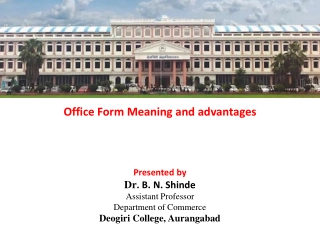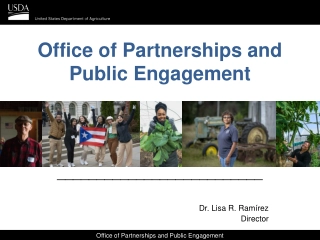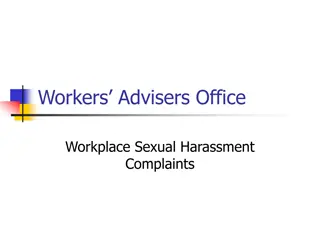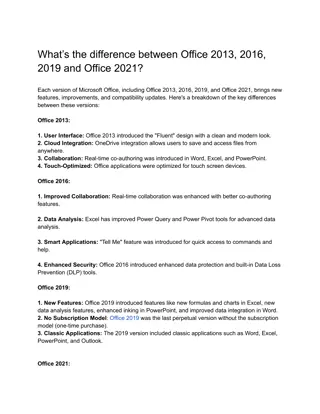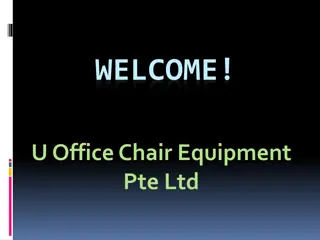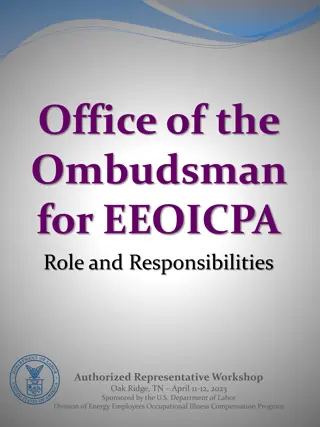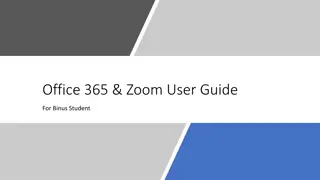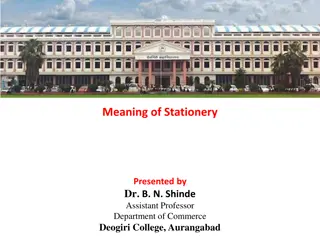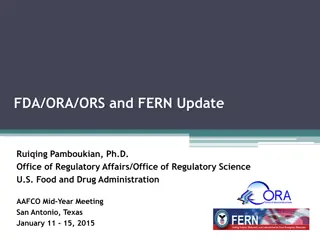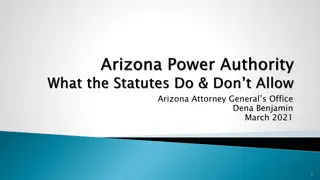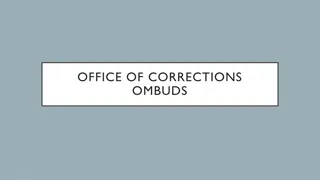
Evaluation of Public Health Infrastructure Grant in Missouri
"Learn about the evaluation standards and process for the Public Health Infrastructure Grant (PHIG) in Missouri, including the monitoring assessment and workforce needs survey. Stay informed about the reporting timelines and key details to help improve overall public health in the state."
Uploaded on | 0 Views
Download Presentation

Please find below an Image/Link to download the presentation.
The content on the website is provided AS IS for your information and personal use only. It may not be sold, licensed, or shared on other websites without obtaining consent from the author. If you encounter any issues during the download, it is possible that the publisher has removed the file from their server.
You are allowed to download the files provided on this website for personal or commercial use, subject to the condition that they are used lawfully. All files are the property of their respective owners.
The content on the website is provided AS IS for your information and personal use only. It may not be sold, licensed, or shared on other websites without obtaining consent from the author.
E N D
Presentation Transcript
Public Health Infrastructure Grant LPHA Evaluation Meeting-2.6.24 Agenda PHIG Evaluation Updates PHIG LPHA Evaluation Assessment Template Tool Review Frequently Asked Questions Additional Questions/Concerns *This meeting is being recorded and the PowerPoint and Webex recording will be available on the LPHA Resources site: https://health.mo.gov/living/healthcondiseases/communicable/novel-coronavirus- lpha/.
Public Health Infrastructure Grant Evaluation In effort to meet the Public Health Infrastructure Grant (PHIG) evaluation standards of the CDC as well as gather valuable information for PHIG funded awardee deliverables to improve overall public health in Missouri, the Department of Health and Senior Services has partnered with the University of Missouri Health Behavior Risk Research Center of the School of Medicine to design and implement the evaluation for the PHIG in Missouri. There are 2 separate pieces for evaluation of the PHIG that will be administered: The PHIG Evaluation Monitoring Assessment The PHIG Public Health Workforce Needs Survey
PHIG Evaluation Monitoring Assessment The PHIG Evaluation Monitoring Assessment will be sent out to LPHA Administrators/Directors via an email that contains a link to the assessment in Redcap. The Redcap link to the assessment will also be available on the DHSS LPHA Resources page under the Public Health Infrastructure Grant/Contract Information dropdown section. *This will be available very soon. The first assessment report from LPHAs will be due July 15, 2024 and will seek to capture LPHA data from 12/1/23 to 5/31/24. *If an LPHA PHIG contract did not become finally executed until after the start of the reporting period (12/1/23) we ask that the LPHA begin reporting from the day the contract received final execution.
PHIG Evaluation Monitoring Assessment Reporting Period -Monitoring Assessment Report Timeline The initial reporting period for LPHAs for the PHIG Evaluation Monitoring Assessment has shifted: LPHA Assessment Submission Date Year Reporting Period 1 2 3 4 5 6 7 8 9 10 Dates 12/1/2022-5/31/2023 NA Year 1 6/1/2023-11/30/2023 7/15/2024 1/15/2025 7/15/2025 1/15/2026 7/15/2026 1/15/2027 7/15/2027 1/15/2028 12/1/2023 5/31/2024 Year 2 6/1/2024 11/30/2024 12/1/2024 5/31/2025 Year 3 6/1/2025 11/30/2025 12/1/2025 5/31/2026 Year 4 6/1/2026 11/30/2026 12/1/2026 5/31/2027 Year 5 6/1/2027 11/30/2027
PHIG Evaluation Monitoring Assessment The PHIG Evaluation Monitoring Assessment will cover 4 topics under the Workforce and Foundational Capabilities Strategies (*Data Modernization Strategy is not included in the assessment currently). 1. Hiring 2. Retention 3. Hiring Timeliness 4. Accreditation Involvement and Readiness
PHIG Evaluation Public Health Workforce Needs Survey Status Update: The PHIG PH Workforce Needs Survey is designed to be completed by the Missouri LPHA workforce at all levels. Its release has been delayed and it is currently in the process of DHSS internal review and will be submitted to the IRB*. Survey link is expected to arrive via email to LPHA Administrators/Directors in early March, 2024. DHSS Administrators/Directors will be asked to forward survey link to staff. Responses are anonymous; no personal identifying information gathered; sensitive data will be reported at the state level. Estimated completion time of survey is <15 minutes *DHSS is requesting exemption from IRB
A Look at the PHIG Evaluation Assessment Template Tool Purpose of the Template: An optional tool created to help track data over each PHIG evaluation reporting period that will go into the PHIG Monitoring Assessment in Redcap. Note: Redcap does also allow for a save function for data via a link, but due to concerns over loss of saved data this tool was created to give the user an additional save option. By keeping the template up-to-date for each reporting period, the LPHAs can not only track PHIG data reported to the CDC, but easily transfer to the assessment in Redcap.
Frequently Asked Questions How do we count part time vs. full-time staff? The PHIG data collected by the CDC does not distinguish between part-time and full-time staff. They are counted the same. Our LPHA shares a newly hired staff member brought on this reporting period with a neighboring LPHA using PHIG funds. Would this employee be counted by both LPHAs? Yes, each LPHA would count the staff member as a new hire assuming they began working during the reporting period. We hired a new staff member using PHIG funds. We do not have funds to employ them beyond the PHIG funding contract period at this time. Are they a temporary or permanent employee? If the new hire did not sign a contract or receive an official designation stating they are a temporary/contract employee then count them as a permanent staff member. If we had a new hire that started during the reporting period but also left during the reporting period, should we count them? No, you should not count them. If the position leaves and is filled by an additional new hire all within the same reporting period, it would count as one.
Frequently Asked Questions We have had certain continual job postings for years as they are positions we are constantly trying to hire for. Do we put the job posting date even if it was posted 3 years ago? Yes, try to input the date of the original job posting if known. There is a contextual information box at the end of the survey where you can comment on this situation. How do I count a new hire that had their job position posted this reporting period but they do not start until the next reporting period? You would not count them as only new hires that began working during the reporting period should be counted in each assessment report (every 6 months). We had an existing staff member that became PHIG funded this reporting period. How do we count this staff member? You would count in both the Existing Staff Numbers tab and the New Hires tab. You would list them under the Existing Staff Numbers tab and select their funding source as it existed on Day 1 of the reporting period. You would also list them under the New Hires tab as a new hire and select PHIG funded as well as input the date they started under PHIG funds.
Frequently Asked Questions Do you have a CDC definition for a temporary/contract staff member? The following definition for temporary/contract staff was provided by CDC for reporting under the Public Health Infrastructure Grant: Temporary/contract staff: Temporary/contract staff have a defined duration of employment. Temporary/contract staff are not typically eligible for benefits through the government agency. Includes limited-term employees (LTEs). Example 1: We have hired an employee on a 2 year contract. We hope to keep them on longer and renew their contract at the end of 2 years. Do we report them in the assessment as a permanent or temporary/contract employee? Report them as a temporary employee as they have a defined duration of employment (2 years). Example 2: We have hired a new staff using PHIG funds. We have told them that once PHIG funding ceases, our ability to keep them on as a staff member depends on if new funding becomes available. We have hired them as a regular staff member with the same benefits granted to other staff and they have no written contract or written internal designation as a temporary/contract employee. Do we report them as a permanent or temporary employee in the PHIG assessment? Report them as a permanent staff member as there is no defined duration of employment (it s ambiguous).
Frequently Asked Questions We are paying staff with incentive money that is routed into their salary paycheck. The incentive stipends are spread out over a year. Do we count the staff member as being PHIG funded when their regular salary outside of the incentive is not PHIG funded? You would not count the staff member as PHIG funded, but rather funded by an other source. Where do we count WIC breastfeeding counselors at in the Existing Staff Numbers tab? They can be counted und the Job Category, Behavioral Health and Social Services Staff and under the Job Title, Counselor or Other . Use same designation for counting WIC breastfeeding counselors as new hires under the New Hires tab.
Frequently Asked Questions When I try to use the optional PHIG LPHA Assessment Template Tool in Excel, I am unable to select a Job Title from the drop down selection in the New Hires tab. First, make sure you have removed excel document from protected view by clicking Enable Editing at the top of the spreadsheet. Within the New Hires tab, make sure you have selected a category in the Job Category column (column B). You will not be able to select a Job Title in column C if a Job Category is not selected. If you have selected a Job Category and still do not see any selections under the respective Job Title cell, make sure you have scrolled up on the cell to see all available choices:
This work is supported by funds made available from the Centers for Disease Control and Prevention (CDC) of the U.S. Department of Health and Human Services (HHS), National Center for STLT Public Health Infrastructure and Workforce, through OE22-2203: Strengthening U.S. Public Health Infrastructure, Workforce, and Data Systems grant. The contents are those of the author(s) and do not necessarily represent the official views of, nor an endorsement, by CDC/HHS, or the U.S. Government. travis.fisher@health.mo.gov

